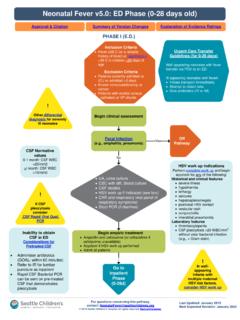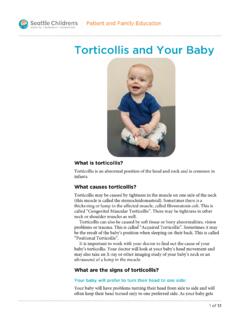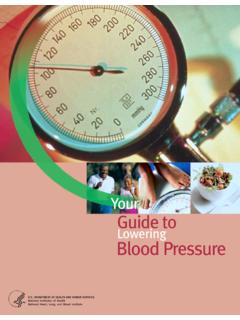Transcription of Neonatal Hypertension - Seattle Children's
1 Neonatal Nursing Education Brief: Neonatal Hypertension Neonatal Hypertension is not a common finding in healthy neonates. However, high-risk infants requiring NICU care are at elevated risk. There are several factors that can contribute to the development of Hypertension . Optimal outcomes depend on prompt recognition and treatment. Hypertension , NICU, cardiovascular system, thrombus, vascular disease Neonatal Hypertension Purpose and Goal: CNEP # 2081 Learn about Hypertension in the neonate. Learn about best practices for treating Hypertension . None of the planners, faculty or content specialists has any conflict of interest or will be presenting any off-label product use.
2 This presentation has no commercial support or sponsorship, nor is it co-sponsored. Requirements for successful completion: Successfully complete the post-test Complete the evaluation form Date July 2018 July 2020 Learning Objectives Describe the risk factors for Neonatal Hypertension Describe the clinical presentation of Neonatal Hypertension Describe 2 approaches for the treatment of Neonatal Hypertension Introduction Hypertension is not common in neonates But the incidence rises in NICU infants Standard definitions of Hypertension have been identified Identifying Hypertension is important Identification can lead to.
3 Appropriate etiology Appropriate evaluation Appropriate management Appropriate pharmacotherapy Neonatal Hypertension Hypertension is seen in less than of infants The incidence rises in high-risk NICU infants Up to 3% in infants requiring NICU care Kidney development continues until 36 weeks Preterm birth interrupts nephrogenesis Neu Preterm infants are already at risk Other additional risk factors include: Umbilical arterial catheters Bronchopulmonary dysplasia Intraventricular hemorrhage Acute renal failure Chronic renal failure Congenital heart disease Congenital anomalies Kidneys Urinary tract There is growing evidence genetics plays a role Hypertension is diagnosed based on.
4 Systolic or diastolic values Persistently greater than 95th percentile On 3 separate occasions Based on post-conceptual age Normal Infant Blood Pressure Ranges Normal BP ranges have been established Ranges are based on post-conceptual age BP normal ranges increase with PCA 26 weeks PCA 50th percentile 55/30 MAP 38 95th percentile 72/50 MAP 57 99th percentile 77/56 MAP 63 28 weeks PCA 50th percentile 60/38 MAP 45 95th percentile 75/50 MAP 58 99th percentile 80/54 MAP 63 30 weeks PCA 50th percentile 65/40 MAP 48 95th percentile 80/55 MAP 63 99th percentile 85/60 MAP 68 32 weeks PCA 50th percentile 68/40 MAP 49 95th percentile 83/55 MAP 64 99th percentile 88/60 MAP 69 34 weeks PCA 50th percentile 70/40 MAP 50 95th percentile 85/55 MAP 65 99th percentile 90/60 MAP 70 36 weeks PCA 50th percentile 72/50 MAP 57 95th percentile 87/65 MAP 72 99th percentile 92/70 MAP 77 38 weeks PCA 50th percentile 77/50 MAP 59 95th percentile 92/65 MAP 74 99th percentile 97/70 MAP 79 40 weeks PCA 50th percentile 80/50 MAP 60 95th percentile 95/65 MAP 75 99th percentile 100/70 MAP 80 42 weeks PCA 50th percentile 85/50 MAP 62 95th
5 Percentile 98/65 MAP 76 99th percentile 102/70 MAP 81 44 weeks PCA 50th percentile 88/50 MAP 63 95th percentile 105/68 MAP 80 99th percentile 110/73 MAP 85 Standardized Method for Measuring BP Position prone or supine Use a standard oscillometric device Use an appropriate cuff size Cuff width to arm circumference ratio Use a preferred site Right upper arm Use preferred timing Infant should be asleep If awake, infant should be quiet Infant should not be disturbed For 15 minutes after cuff placed Feeds or interventions Should have been at least hours before Obtain the preferred number of BP readings At least 3 readings Taken 2 minutes apart Etiology and Risk Factors for Neonatal Hypertension Several factors are associated with Hypertension The most commonly involved factors are: Renal parenchymal disease Renal vascular anomalies Congenital anomalies may also be involved.
6 Polycystic kidney disease Multi-cystic dysplastic kidneys Ureteropelvic junction obstruction Urethral obstruction The most common non-renal factors are: Chronic lung disease Bronchopulmonary dysplasia Occurs in 13 43% Factors associated with Hypertension include: Maternal factors Maternal Hypertension Heroin or cocaine use Antenatal steroid exposure Maternal BMI >30 Maternal diabetes Abnormal utero-placental perfusion Prematurity Low birthweight Perinatal hypoxia Renal vascular thrombosis Renal artery thrombosis Renal vein thrombosis Occurs in 10% From umbilical catheter placement Occurs in 2 9% Vascular endothelial disruption Thrombi form at the tip of the catheter Thrombi form adjacent to catheter tip Thrombi can occlude aortic blood flow Most common with prolonged use Renal artery stenosis Renal artery compression From tumors
7 Renal parenchymal disease Polycystic kidneys Acute tubular necrosis Acute kidney injury Cardiac disease Patent ductus arteriosus Coarctation of the aorta Medications Steroids Caffeine Phenylephrine Indomethacin Vasopressors Bronchodilators Parenteral nutrition Excess volume Sodium overload Hypercalcemia ECMO Bronchopulmonary dysplasia Endocrine disorders Congenital adrenal hyperplasia Hyperaldosteronism Hyperthyroidism Pseudohypoaldosteronism type II Seizure disorders Neoplastic disorders Neuroblastoma Wilms tumor Intraventricular hemorrhage Acquired Acute tubular necrosis Cortical necrosis Interstitial nephritis Nephrocalcinosis Hemolytic uremic syndrome Unmanaged pain Clinical Manifestations of Neonatal Hypertension Clinical manifestations include.
8 Asymptomatic Most infants shown no signs Cardiorespiratory signs Tachypnea Cyanosis Cardiomegaly Hepatomegaly Heart failure Mottled color Unequal pulses Deceased pulses Neurologic signs Lethargy Tremors Seizures Hypertonicity Hypotonicity Apnea Opisthotonos Hemiparesis IVH Asymmetric refluxes Retinopathy Renal signs Renal enlargement Sodium wasting Oligoanuria Polyuria Other signs Failure to thrive Abdominal distension Edema Adrenal mass Fever Diagnostic Evaluation of Neonatal Hypertension Most infants with Hypertension are asymptomatic Diagnosis is made by routine serial BP monitoring Once recognized, an evaluation should occur A general approach includes: Was the BP cuff the right size?
9 Was the BP taken using standard methods? Does the BP meet criteria for Hypertension ? Are there risk factors in the infant s history? Does the physical exam indicate a cause? Focus on cardiovascular exam Focus on abdominal exam Focus on genitourinary exam Order appropriate labs and ultrasounds Address the etiology and treat appropriately A specific approach includes: History Maternal Steroids Cocaine Heroin Hypertension Diabetes Obesity Prenatal Oligohydramnios Polyhydramnios Renal anomalies Postnatal Steroids Adrenergic agonists Indomethacin Caffeine Umbilical catheters Targeted physical exam Volume status Weight trends Dysmorphic features Genetic abnormality External ear abnormality Genetic syndrome Cardiovascular 4 extremity BPs Murmurs Femoral pulses Brachial pulses Genitourinary and renal Abdominal masses Abdominal bruits Abdominal wall anomalies Genitalia Congenital adrenal hyperplasia Laboratory
10 Investigation Urinalysis Electrolytes Calcium BUN Creatinine Additional investigations Thyroid studies Plasma renin activity Aldosterone Cortisol 11-deoxycortisol 11-deoxycorticosterone Plasma catecholamines Urine catecholamines Metanephrines Normetanephrines Radiologic studies Aortic ultrasound With Doppler flow Renal ultrasound With Doppler flow VCUG CT angiogram Evaluate aorta Evaluate renal arteries Nuclear medicine studies DMSA or MAG3 scans Captopril renal scan Cranial ultrasound Cranial MRI Cardiology Echocardiogram Management of Neonatal Hypertension Management should be individualized Optimal management remains uncertain The timing of antihypertensive therapy is controversial Most infants require treatment for short periods Some for only 10 days Six months is average Most experts agree Hypertension should be treated Untreated Hypertension can lead to.
















